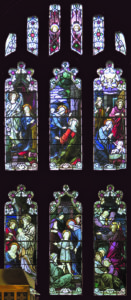Joyful Mysteries in Stained Glass
St Mary of the Angels in Wellington is a church in the care of Marists. The stained glass windows were imported from Germany in the 1920s, except for four that were salvaged from the first church, destroyed by fire in 1918. For a stained glass enthusiast like myself, they are a delight, and the stories they tell are wide-ranging.
The 16-a-side top windows in the nave tell the story of Jesus’ life, his miracles and the parables he told. The eight lower windows in the nave are of saints, and the windows in the left chapel mainly tell of Joseph’s life. There is a magnificent crucifixion scene above the altar. The windows in the right chapel are two of the original windows (Sts Joachim and Anne) and sets featuring the Mysteries of the Rosary. This article highlights the set of Joyful Mystery windows [1].
The first Joyful Mystery is the Annunciation, when the angel Gabriel was sent by God to a virgin betrothed to Joseph, and told her she was to bear a son to be called Jesus. She was puzzled, and asked “How can that be”? The angel reassured her, telling her that God would make it happen and not to be afraid. This window [2] shows the scene as the artist imagined it. The angel’s words in Latin are the familiar “Hail, Mary, full of grace”.
The beauty of the window inspires me, leaving me to contemplate the trust Mary placed in God. She must have thought “How can I conceive”? In those times, getting pregnant before marriage, even if betrothed, would have been very dangerous for her. The Gospel of Matthew tells us that Joseph married Mary.
Despite all that, Mary said “Yes” to God. I can’t help wondering if I would have the same trust in God - and then I look back and see all the times I have trusted him in the past.
The angel also told Mary about her cousin Elizabeth being six months pregnant, and so Mary set off for the hill country of Judah “as quickly as she could”. I wonder how long it took her? She probably went with other people, because I doubt that her family and Joseph would have permitted her to travel alone. How tired she must have been when she arrived at Zechariah’s house.
The Visitation, as it is known, is depicted beautifully [3]. Mary’s trailing scarf gives an impression of the hasty journey, Elizabeth is kneeling as she greets the “mother of her Lord”. The child had leapt in her womb, and she knew without being told what had happened at the Annunciation. Then Mary spoke the Magnificat.
As I meditate on the Visitation, I hear the words of the modern Magnificat ringing in my ears - My soul does magnify the Lord, and my spirit has rejoiced in God my Saviour, for he that is mighty has done great things, and holy is his name - and I realise why this mystery is joyful.
The third Joyful Mystery is the Nativity. The scene is depicted [4] simply as Jesus lying in the manger, Mary looking recovered from her labour, Joseph and a shepherd leaning on their staffs. As I meditate on the mystery of Jesus coming as a child to give me new life, I can’t help but be joyful and give thanks to God for his love for us. At the same time, my heart goes out to Mary as she gives birth - young, inexperienced, alone with her husband in a stable in a strange town.
The fourth Joyful mystery is the Presentation of Jesus in the Temple [5]. Technically, every child born belonged to God, but after thirty days Jesus had to be presented in the temple and redeemed by payment of 5 shekels. At the same time, two doves had to be sacrificed to purify Mary. The window has some of these elements - Joseph is holding a birdcage with the pigeons, but there is no money bag with the 5 shekels. There were prophecies about Jesus from Simeon and Anna, with only Simeon being shown in the window. The window helps me to focus on Simeon’s powerful prophecy “my eyes have seen the salvation which you have prepared for all the nations to see” and wonder what Mary thought of it all.
/ezcol_1half_end]
The last Joyful Mystery is the Finding of Jesus in the Temple [6]. Mary must have really panicked when she realised that they had “lost” Jesus, and was “overcome” when they found him three days later with the temple leaders. I can empathise with Mary when she, in her relief, rebuked him for staying in the temple when he knew that they might be worried about him. The young Jesus then returns the rebuke: “Don’t you know that I must be about my Father’s business”. The Gospel says that they didn’t understand what he meant.
Looking at the window, I wonder at the depiction of Jesus as blonde in what looks like a dress. Of course, I have no idea of how he would have been dressed, but I like to think that at twelve years old he would have been dressed as a young man. That’s how I see Him, anyway.
But, they are mysteries, and these windows have given me lots of joy. I suppose that’s why they are the Joyful Mysteries.







 Entries(RSS)
Entries(RSS)